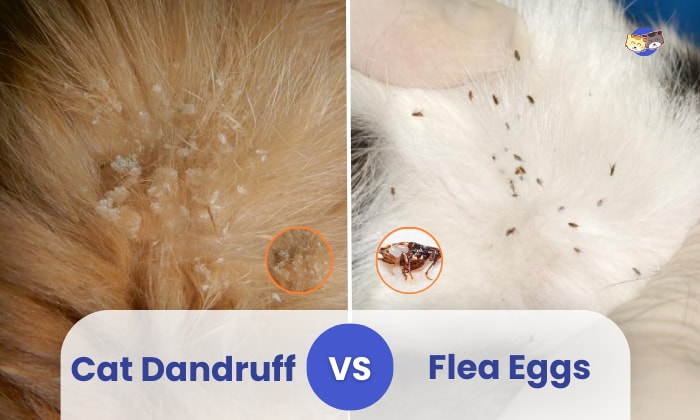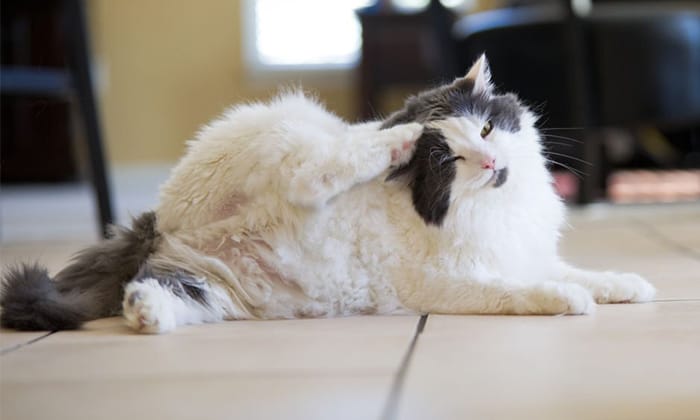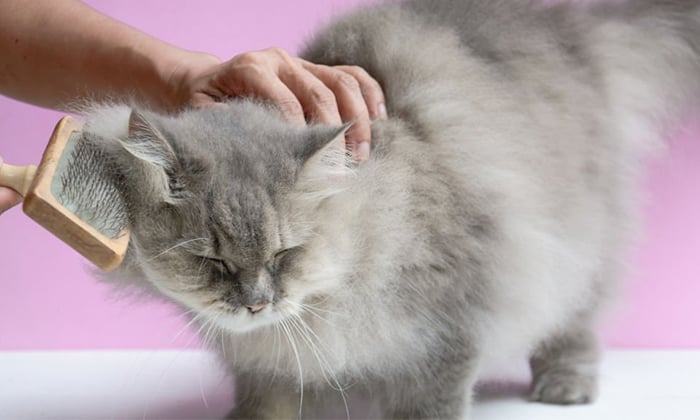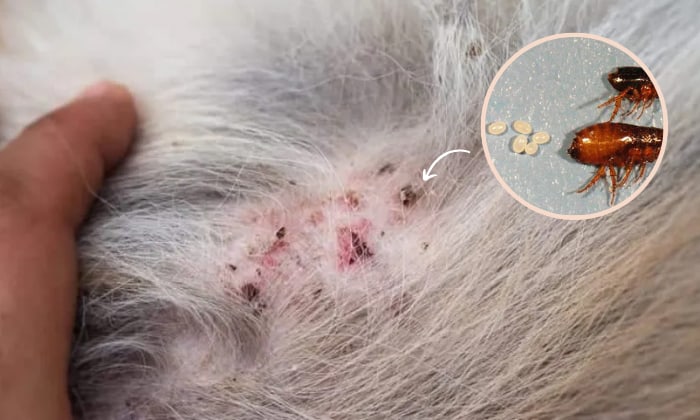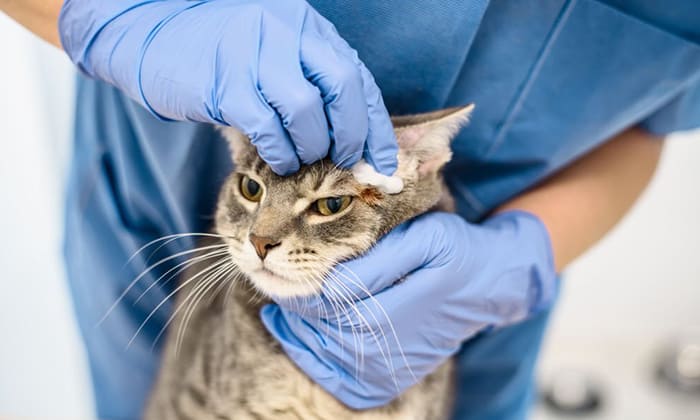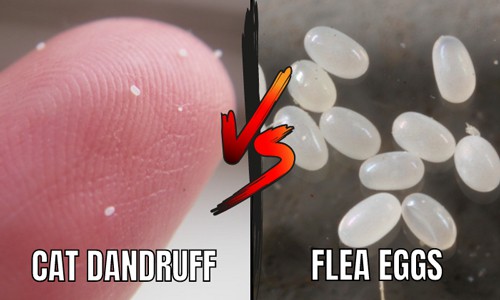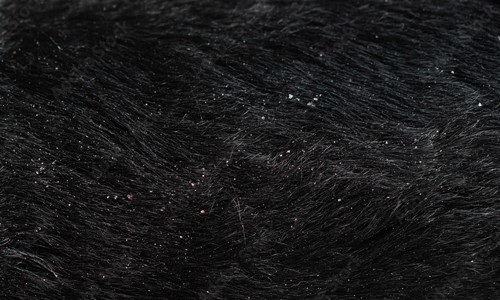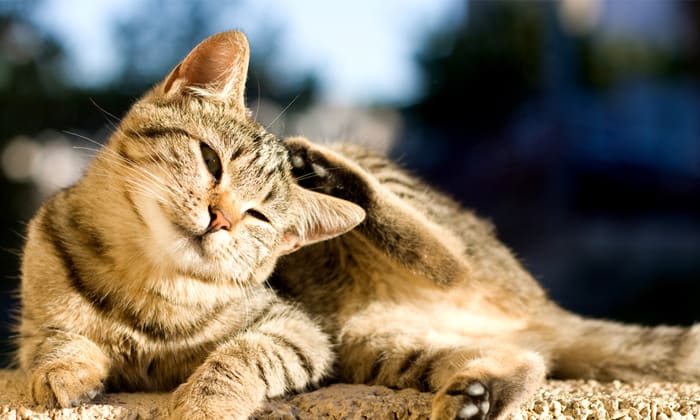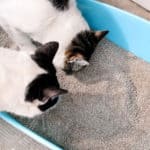Identifying skin problems in felines can sometimes be tricky. Their fur covers their skin, making assessing what is happening underneath challenging.
But some health problems are serious enough to show on your pet’s fur. For instance, dandruff and flea eggs appear as white specks in cat fur. Therefore, feline owners may find it tricky to tell the differences.
So, in this article, we’ll help you identify cat dandruff vs. flea eggs and have proper treatment for your cat.
Table of Contents
Cat Dandruff
Feline dandruff is a condition that causes the flaking of your pet’s skin. So, the common first symptoms of dandruff in cats are feeling dry and itchy.
The skin will start flaking as the condition worsens, causing gray and white flakes on your pet’s fur.
Dandruff can be a sign of a more serious health problem in cats. So, once you see signs of dandruff on your feline, treating it immediately is vital.
Treatment
Cat dandruff treatment depends on its cause. However, there are some general treatments that you can do to help manage feline dandruff.
- Use moisturizing products. As mentioned, dandruff causes skin dryness. So, you can apply moisturizing products to your pet’s skin to get rid of dryness and irritation.
- Tailor a nutritious diet. Lack of proper nutrition can also cause dandruff. Therefore, ensure you include skin-beneficial food, such as fish oil and omega-3 fatty acids, into your pet’s diet.
- Regular baths. There are cat shampoos and conditioners for dandruff treatment. But while baths are necessary for your pet, do not over-bath it, as it can change its skin’s pH level.
- Regular coat brushing. While brushing mainly benefits your pet’s fur, you can also use it as a treatment and prevention for dandruff. Brushing your feline friend’s fur with a soft-toothed comb massages its skin, thus distributing the cat’s natural oils.
- Consult a veterinarian. It is worth noting that the aforementioned treatments will only help manage kitten dandruff if its underlying cause is a more serious medical condition. For this reason, consulting a veterinarian for proper diagnosis and treatment is vital.
Feline Flea Eggs
As the name suggests, flea eggs are caused by fleas infesting your furry friend’s skin. They are difficult to detect, as they only measure 0.5 millimeters.
Flea eggs are about the size of a grain of salt, with an off-white color and an oval shape. Feline caretakers often mistake flea eggs for sand or dry, flaking skin.
But unlike dandruff, feline flea problems cause you to find flea dirt and adult fleas on your pet’s fur.
Treatment
If you don’t get rid of flea eggs before they hatch, you are risking your pet into a serious infestation. That said, below are some effective ways of removing fleas and flea eggs from your feline friend’s fur:
- Use a fine-toothed metal comb. Combining your cat’s fur from head to tail will help extract fleas and flea eggs. After every stroke, dip the comb in hot water mixed with dish soap to kill the fleas.
- Clean your pet’s environment. As mentioned, flea eggs do not stick to a cat’s fur. So, these eggs fall off your pet’s surroundings, including its bedding and toys.
Without cleaning your feline’s environment, these flea eggs will hatch and make their way back into your pet’s fur. So, when treating fleas and flea eggs, you need to wash your pet’s items and its environment to get rid of the infestation.
- Bath your pet using a flea shampoo. There are shampoos and conditioners specially formulated to kill fleas and flea eggs. But when choosing your cat’s shampoo, consulting a veterinarian is ideal to ensure that the product will not cause any allergic reactions.
Flea Eggs Vs. Dandruff in Cats: Spotting the Differences
In the eyes of an uninformed caretaker, cat dandruff and flea eggs may look the same. However, knowing how these two skin conditions differ is crucial in properly treating your feline friend.
Here are the differences between feline dandruff and flea eggs:
1. Appearance
Cat dandruff looks like white or gray flakes on your furry friend’s fur. They may also stick on the animal’s skin, similar to how dandruff looks on a human scalp.
There is also black cat dandruff, which is caused by feline acne.
If you look at the pictures above, flea eggs are oval and off-white. They are almost microscopic, so they can be difficult to spot on your feline’s coat. Chorion, a soft shell, covers flea eggs. These insect eggs are also thicker than dandruff flakes.
2. Causes
If you wonder, “Why does my cat have dandruff,” two of the most common causes are fungal and bacterial infections.
Apart from skin infection, poor nutrition, allergies, and flea infestations can also cause dandruff. Medical conditions, such as hypothyroidism and cancers, can also cause your furry friend’s skin to become dry and itchy.
Meanwhile, flea eggs are produced by adult fleas. These small parasites live on your pet’s skin and fur, feeding on their blood for nutrition.
Once fleas reach their adult stage, they can lay up to 50 eggs per day.
3. Symptoms
At a glance, cat dandruff looks like white specks on your pet’s fur. Once you push the cat’s coat apart, you’ll see that its skin is inflamed, dry, and flaky.
You may also notice your feline friend scratching and grooming itself more than usual. If your feline’s dandruff is severe, it may also have bald patches caused by excessive scratching.
The most obvious sign of fleas in cats is black specks on their fur or bedding. These black specks are flea dirt, which means there are adult fleas reproducing on your pet’s skin.
You’ll find flea eggs as white specks on your feline’s fur. But as flea eggs cannot stick to cat fur, they fall off when your pet moves.
So, you need to look out for adult fleas and flea dirt to confirm whether your furry friend has an infestation.
4. Effects On Cats
Dandruff makes felines suffer from extreme itchiness. Your pet will lick, scratch, and bite the affected area, which can result in baldness and a wound.
Failure to treat cat dandruff can result in secondary infections.
Meanwhile, flea eggs do not affect your feline in any way. But once they hatch, they can cause a severe flea infestation, which is extremely itchy for your furry friend.
Without proper treatment, this infestation can cause anemia, as the fleas will feed on your pet’s blood.
Bad Effects of Dandruff and Flea Eggs on Cats
- Without proper treatment, feline dandruff and flea eggs can cause skin inflammation, and irritation. Your pet will constantly scratch its skin, which can result in hair loss, redness, and redness.
- The constant scratching can also cause open wounds, while your pet’s paw can introduce bacteria and pathogens. These bacteria can lead to secondary infections.
- Moreover, the anemia caused by a severe flea infestation can lead to weakness, lethargy, and health issues.
- Cat dandruff and flea eggs can also result in behavioral changes like irritability and restlessness.
For these reasons, it is important to address feline dandruff and flea eggs promptly.
Frequently Asked Questions
How to prevent cats from getting dandruff and flea eggs?
We can trace back to the cause of these diseases to know the prevention methods necessary to protect our cats from them.
In the case of dandruff, it’s best to have a good diet for cats to avoid obesity and poor nutrition. Furthermore, it’s important to maintain good hygiene and your cat’s fur and skin.
Meanwhile, the chance for cats to have flea eggs will drop if you keep the cat’s living environment clean daily. Bathing and combing the right way is also necessary to avoid flea eggs. You might not want to leave your cats playing outside in a dirty place for too long due to the risk of infestation.
How do I know if my cat has flea eggs?
One way to find out if your cat has flea eggs is to look out for adult fleas. Adult fleas are more noticeable than their eggs, so they are easier to detect.
Looking for fleas can also help you get rid of them, thus stopping them from producing eggs. You may also look for black specks, which are flea dirt, on your pet’s skin and fur.
Read more: Cat fleas vs dog fleas: what is the difference?
How much time does it take for flea eggs to hatch?
Flea eggs can only take one to ten days to hatch. However, the exact number of days will depend on environmental conditions, including humidity and temperature.
After the egg stage, fleas enter the larvae stage. Although they are not adult fleas yet, larvae can already move and feed on your furry friend’s blood.
Does cat dandruff affect humans?
There are no records of people contracting dandruff from felines. However, walking dandruff, which is caused by Cheytiella mites, can affect humans.
Walking dandruff has the same symptoms as seborrheic dermatitis (feline dandruff), including skin dryness and flaking. The mites that cause this condition can cause irritation and rashes in humans, although they cannot survive in a human host for a long time.
Conclusion
Cat dandruff vs. flea eggs – while these conditions are far different, they can result in extreme skin irritation for your pet. This irritation may sound simple, but it can cause serious medical conditions.
Feline dandruff may be a result of an underlying health problem, while flea eggs are a result of a parasite infestation. Without proper treatment, both conditions can adversely affect your pet’s quality of life.
So, before your cat’s dandruff or flea infestation takes a turn for the worse, visiting a veterinarian and getting proper treatment is crucial.

I am Amy Sawy, a Doctor of Veterinary Medicine (DVM) graduate from the University of Kansas. y husband, Dr. Plummer, and I own a veterinary clinic in Phillipsburg, Kansas. In addition to my professional background, I am a devoted pet owner myself, with a household that includes dogs, rodents, and most notably, cats – a total of five felines in my home.
In 2020, I joined an organization as a professional writer, leveraging my experience and collaborating with my team to deliver the most valuable information for your cat’s care.


